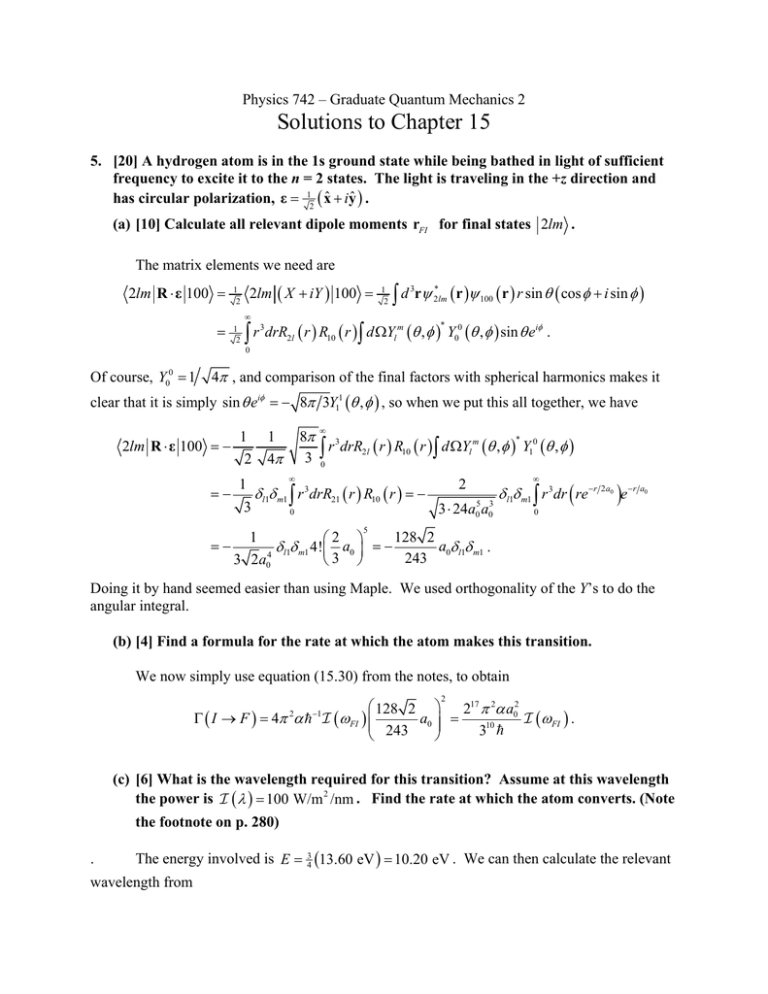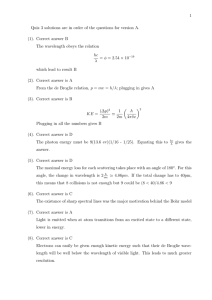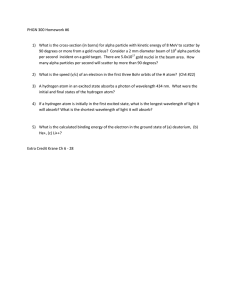Solutions to Chapter 15
advertisement

Physics 742 – Graduate Quantum Mechanics 2 Solutions to Chapter 15 5. [20] A hydrogen atom is in the 1s ground state while being bathed in light of sufficient frequency to excite it to the n = 2 states. The light is traveling in the +z direction and has circular polarization, ε 12 xˆ iyˆ . (a) [10] Calculate all relevant dipole moments rFI for final states 2lm . The matrix elements we need are 2lm R ε 100 1 2 2lm X iY 100 1 2 d r r r r sin cos i sin 3 * 2 lm 100 1 2 r drR r R r d Y , Y , sin e . 3 m 2l 10 * l 0 0 i 0 Of course, Y00 1 4 , and comparison of the final factors with spherical harmonics makes it clear that it is simply sin ei 8 3Y11 , , so when we put this all together, we have 2lm R ε 100 1 2 8 3 * r drR2l r R10 r d Yl m , Y10 , 3 0 1 4 1 2 l1 m1 r 3drR21 r R10 r r 3 dr re r 2 a0 e r a0 5 3 l1 m1 3 3 24a0 a0 0 0 5 1 128 2 2 a0 l1 m1 . 4! a0 4 l 1 m1 243 3 2a0 3 Doing it by hand seemed easier than using Maple. We used orthogonality of the Y’s to do the angular integral. (b) [4] Find a formula for the rate at which the atom makes this transition. We now simply use equation (15.30) from the notes, to obtain 2 128 2 217 2 a02 a0 FI . I F 4 FI 310 243 1 2 (c) [6] What is the wavelength required for this transition? Assume at this wavelength the power is 100 W/m 2 /nm . Find the rate at which the atom converts. (Note the footnote on p. 280) . The energy involved is E wavelength from 3 4 13.60 eV 10.20 eV . We can then calculate the relevant c hc 1240 nm eV 121.5 nm . f E 10.20 eV We then calculate the intensity per unit angular frequency as 121.5 nm 100 W/m 2 /nm 2 7.84 1013 W s/m 2 . 8 9 2 c 2 2.998 10 m/s 10 nm/m 2 Substituting this into our expression, we find 217 2 5.29 1011 m 7.84 1013 J/m 2 2 100 211 10 3 137 1.054 10 34 J s 3.33 s 1 . So even with this rather weak source, an atom will undergo such a transition several times per second. The reverse rate would be the same, except it can be shown that spontaneous emission, a process we have not yet accounted for, is a much faster process.



